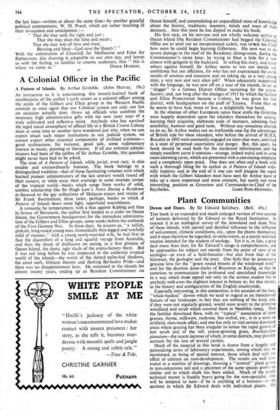Plant Communities
Downs and Dunes. By Sir Edward Salisbury. (Bell. 45s.) Tins book is an expanded and much enlarged version of two courses of lectures delivered -by Sir Edward to the Royal Institution. In essence it is an ecological survey of the downland and dune flora of these islands, with special and detailed reference to the influence of soil-content, climatic conditions, etc., upon the plants themselves; and it must therefore be regarded, to some extent, as a purely technical treatise intended for the student of ecology. Yet it is, in fact, a great deal more than that; for Sir Edward's range is comprehensive, and he approaches his subject not merely from the point of view of an ecologist—or even of a field-botanist—but also from that of the historian, the geologist and the poet. One feels that he possesses a
genuine love for the "green round bosom of the windswept wold" and for the desolate dune-slacks of Braunton or Kenfig, so that he contrives to communicate his profound and specialised knowledge in a way which must appeal not only to the serious student but to anybody with even the slightest interest in botany or, for that matter, in the history and configuration of the English countryside.
Especially interesting, in this connection, is his account of the bare, "whale-backed" downs which we tend to regard as an immemorial feature of our landscape; in fact they are nothing of the kind, and, if they were not regularly-grazed, would soon revert to the primitive woodland and scrub which covered them in Neolithic tins% Thus the familiar downland flora, with its "typical" association of short grasses, thyme, milkwort, rockrose, bee orchid, etc., is in a sense an artificial, man-made affair; and one has only to visit certain downland areas where grazing has been irregular to notice the rapid growth of lo* scrub and of the tall, coarse-growing grass, Brachypodium pinnatum—the recent increase of which, in some districts, may possibly account for the loss of several rarities.
Much of the material in this book is drawn from a lengthy and painstaking series of laboratory experiments, among which mav be mentioned, as being of special interest, those which deal with. the effect of calcium on root-development. The results are well illus- trated in a number of drawings, showing a "control" plant grown in non-calcareous soil and a specimen of the same species grown on similar soil to which chalk has been added. • Much of the purely technical matter is frankly heavy going for the non-specialist, who will be tempted to- turn—if he is anything of a botanist—to the sections in which Sir Edward deals with individual plants. His descriptions of these gain much by the fact that each species is considered, not as an isolated entity, but as a member of the "habitat community" of which it forms a part. The plants are illustrated by numerous photographs taken in situ: many of„ these are excellent, though their merit must necessarily depend to some extent upon the character of the plant itself. Thus the Dune Chickweed is hardly photogenic, nor is the Bastard Toadflax (Thesium ihumilusum), and only the eye of faith could be expected to recognise either as here depicted. Sir Edward writes pleasantly enough, though his syntax is occasion- ally somewhat inelegant. The present reviewer hesitates to carp at inaccuracies, but surely the name Orchis incarnata has now ceased to be valid; and it is hardly true to say of Orchis nizlitaris that "no fresh stations appear to have been observed [for it] since 1939," since its first reappearance after an absence of twenty-five years occurred in 1947. Nor is Orchis purpurea exactly a "rarity" in Kent, where it occurs in over a hundred localities, often very abundantly, and appears, fortunately, to be on the increase. For amateurs of misprints, it may be noted that a former work of Sir Edward's is referred to on p.3 as The East Anglican Flora— a title which might well give rise to some curious speculations in



































 Previous page
Previous page